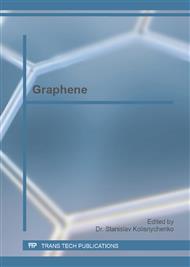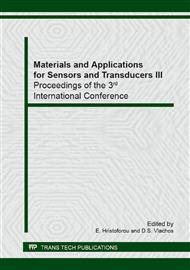p.478
p.483
p.487
p.491
p.495
p.499
p.503
p.507
p.511
The Study of Graphene Gas Sensor
Abstract:
The graphene is suitable for gas sensing applications for its two dimensional char-acter which gives the best possible ratio between sensor surface and volume. The interactionbetween graphene surface and gas molecules can signi cantly change the graphene layer trans-port properties. Therefore graphene can serve as a sensitive layer in a gas sensor. This work isconcentrated on the analysis of the conductivity of graphene layer exposed to di erent gases(NH3, CO2 ...). Together with the electrical measurement on the interdigital graphene sensora simulation based on quantum atomistic approach has been performed. We used ATK toolkitby Quantuwise based on density functional theory (DFT) models. The exchange-correlationpotential is approximated within the generalized gradient approximation (GGA). The trans-port properties of the electrode-device- electrode geometry were calculated by means of non-equilibrium Greens function formalism as implemented in ATK. Experimental conductivitychanges are compared with the simulation results.
Info:
Periodical:
Pages:
495-498
Citation:
Online since:
April 2014
Authors:
Keywords:
Price:
Сopyright:
© 2014 Trans Tech Publications Ltd. All Rights Reserved
Share:
Citation:



